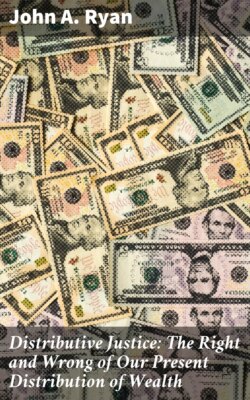Читать книгу Distributive Justice: The Right and Wrong of Our Present Distribution of Wealth - John A. Ryan - Страница 11
На сайте Литреса книга снята с продажи.
No Private Ownership in Pre-Agricultural Conditions
ОглавлениеTable of Contents
Whenever and wherever men got their living by hunting and fishing, there was no inducement to own land privately, except possibly those portions upon which they built their huts or houses. "Until they become more or less an agricultural people they are usually hunters or fishermen or both, and possibly also to a limited extent keepers of sheep and cattle. Population is then sparse and unoccupied territory is plentiful, and questions of the ownership of particular tracts of land do not concern them."[4] In any region occupied by a group or tribe, all portions of the land and the water were about equally productive of game and fish; the amount obtainable by any individual had no relation to labour on any particular piece of soil; and it was much easier for each to range over the whole region in common with his fellows than to mark off a definite section upon which he would not permit others to come, but beyond which he himself would not be permitted to go. In such conditions private ownership of land would have been folly. Tribal or group ownership was, however, in vogue, especially among those groups that were in control of the better grounds or streams. Even this form of proprietorship was comparatively unstable, since the people were to a considerable degree nomadic, and were willing to abandon present possessions whenever there was a prospect of obtaining better ones elsewhere. Among men who got their living by rearing herds, the inducement to hold land in exclusive private control would be somewhat stronger. The better grazing tracts would be coveted by many different persons, especially in the more populous communities. And there would always be the possibility of confusion among the different herds, and contention among their owners. In such circumstances the advantages of exclusive control would sometimes outweigh the benefits of common use and ownership. In the thirteenth chapter of Genesis we are told that, owing to strife between the herdsmen of Abram and Lot, the brothers separated, and agreed to become the exclusive possessors of different territories. Nevertheless, it is probable that tribal ownership was the prevailing form of land tenure so long as people remained mainly in pastoral conditions.
It is likewise probable that the same system continued in many cases for some time after men began to cultivate the soil. At least, this would seem to have been the natural arrangement while land was plentiful, and the methods of cultivation crude and soil-exhausting. It would be more profitable to take up new lands than to continue upon the old. Within historical times this system prevailed among the ancient Germans, some of the tribes of New Zealand, and some of the tribes of Western Africa. Where land was not so plentiful it was sometimes redistributed among individuals or heads of families, as often as a death occurred or a new member arrived in the community. Some of the tribes and peoples who observed this practice were the ancient Irish, the aborigines of Peru, Mexico, and parts of what is now the United States, and Australia, and some of the tribes of Africa, India, and Malaysia.[5] Whether the most primitive agricultural systems of every people were of this nature we have, of course, no means of knowing, but the supposition is antecedently probable; for agriculture must have begun very gradually, and been for some time practised in connection with the more primitive methods of obtaining a livelihood. As the land had been held for the most part in common during the hunting and fishing stage and during the pastoral stage, the same arrangement would probably continue until the people found it necessary to cultivate the same tracts of land year after year, and conceived the desire to retain their holdings in stable possession and to transmit them to their children. Moreover, so long as the members of the clan remained strongly conscious of their kinship, and realised the necessity of acting as a unit against their enemies, there would be a strong incentive to clan ownership of the land, and clan allotment of it among the individual members. In other words, the clan would, in these circumstances, have the same motives for common ownership that exist to-day in the family.
The oldest historical peoples, the Israelites, Egyptians, Assyrians, Babylonians, and Chinese, had private ownership of land at the beginning of their recorded history. Most of them, however, had been cultivating land for a considerable length of time, and had acquired a considerable degree of civilisation, before the earliest period of their existence of which we have any knowledge. It is quite possible that those among them that had passed through the hunting and fishing or the pastoral stage of existence, had practised tribal or common ownership during the earlier portion of their agricultural life.
